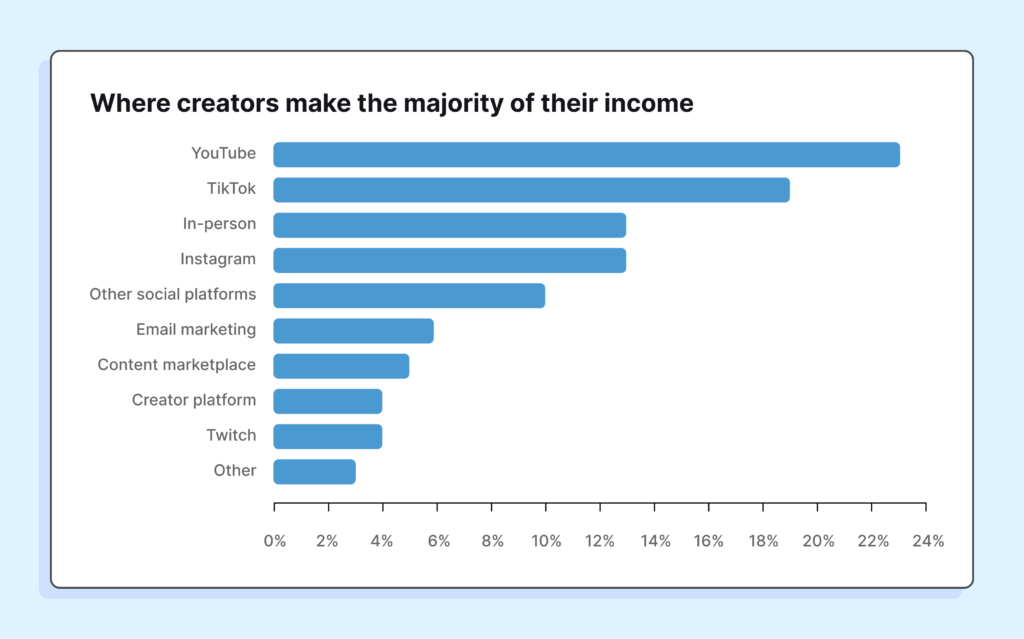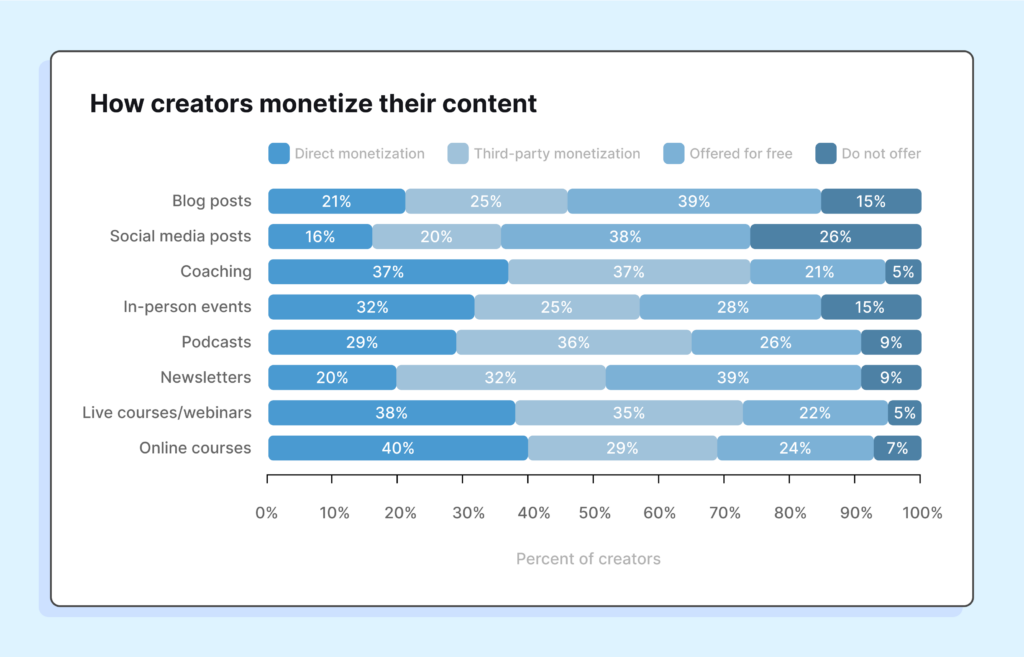In 2022, the creator economy was full of viral moments: ChatGPT made its debut, and, of course, creators graced our feeds on a regular basis offering something to learn or laugh about. At the same time, the creator economy and the enterprises that power it underwent significant transformations. Hundreds of IT jobs were lost at companies like Patreon, Thinkific, and Meta, while financing for creator-related businesses dropped by half. Many people are asking what will happen to the sector now that this has happened.
Despite all of the viral moments and industry transformations, one thing remained constant: creators all across the world were hard at work every day, creating millions of pieces of content. But, the creator economy’s primary issue remains: it does not work for creators. Most creators do not earn enough money from content production to pursue it full-time.
Creator funds are insufficient to pay creators what they should be earning, and at least 69% of creators indicate they rely on brand partnerships to generate money; both income streams are unsustainable monetization strategies, as seen by the fact that just 4.3% of creators earn more than $100,000 per year.
Moving into 2023, organizations in the creator economy will need to focus on creator-first solutions that help tackle the primary monetization challenge. Before we get into our major forecasts and the crucial creator beginning bundle for this year, let’s take a look at creator trends from 2022.
Top creator trends from 2022
Researchers questioned creators on income, monetization techniques, and social media use last year to obtain a sense of creator life. Three major patterns have emerged:
- The majority of creators do not earn enough to pursue their creator company full-time.
- The platforms that support video content are unrivalled.
- The majority of creators rely on third-party monetization to generate money from their content.
Income trends
Everyone wants to know how much creators earn in a digital environment where you may go viral one minute and have many brand sponsorship offers the next — especially amateur creators who want to know if it’s a viable career path.
Researchers asked creators how much money they made from internet sources in the previous year. Surprisingly, 42% of creators earned $10,000 or less, while only 9% earned more than $250,000. Roughly 22% of creators earned less than $1,000 from their content.
YouTube was the biggest platform for creators who generated money from their content, accounting for 23% of their earnings. TikTok came in second, with Instagram and in-person events tied for third.
YouTube was historically one of the few social sites to split ad money with creators via AdSense, which explains its popularity. Nonetheless, the rewards are little, as 97.5% of YouTubers do not earn enough to live in the United States. Sponsored in-feed posts and videos for brand partnerships on TikTok and Instagram are often more profitable than creator fund payouts, which are insufficient for the number of creators on the platforms.
Additionally, there are many options for creators to monetize their content, including direct monetization and third-party monetization. Researchers questioned content creators on how they monetized the following types of content: online courses, live webinars, coaching, newsletters, podcasts, in-person events, ebooks, social media postings, and blog entries. The content might either be given for free or not, according to the creators.
At 40%, online courses were the most preferred option to monetize directly. Coaching was the most popular third-party monetization option, accounting for 35% of the total. Lastly, newsletters and blog posts matched 39% of the top free content categories supplied by creators.

Third-party monetization was the most popular way among creators overall, such as accepting sponsorships on a podcast or putting a #ad on social media. This relates to the fact that 69% of creators claim they rely on third-party monetization, such as brand collaborations, to generate money.
Social media trends
Creators live and breathe social media since it is such an important tool for audience growth and communication. YouTube has the highest percentage of creators (77%). Facebook came in second with 72%, Instagram came in third with 70%, and TikTok came in fourth with 62%.
LinkedIn, with 27% of users, was the least popular social networking platform. YouTube’s popularity validates our prior results that it is the main platform where creators earn the majority of their creator-related revenue. 
Let’s discuss the social media following. There is a common misconception in the creator economy that in order to be a successful creator, you must have hundreds of thousands, if not millions, of followers. But, according to our study results, the majority of creators have fewer than 10,000 social media followers across all platforms.
35% reported follower counts between 1,000 and 9,999, while 26% reported fewer than 1,000. Most creators have less than 50,000 followers, which may be more helpful and appealing to companies because micro-influencers have a highly dedicated and narrow following with a greater engagement level.

Researchers also questioned creators about which social media activity they engaged in. Did they, for example, collaborate with a company on a campaign or present a live video event on a social feed? Responding to comments and queries on articles and stories was the most popular action indicated by creators (48%).
Third, 36% of creators claimed they make digital items to supplement their influencer marketing (you can define influencer for yourself). Interacting with your audience online is a must for creators; replying to comments and queries on articles is a wonderful place to start when it comes to developing a genuine brand and increasing consumer engagement. Overall, these 2022 results confirm that creators are actively creating plenty of content, particularly on social media, but only the top few are receiving the biggest benefits.
Creator economy predictions and tendencies for 2023
There have already been several forecasts about what would happen to the creator economy in 2023, including the emergence of hot new AI technologies, YouTube and TikTok competing for viewers, increased creator fatigue, and TikTok replacing Google as the next search engine.
The most painful elephant in the room, however, is that creators are rapidly discovering that depending on social media for payment does not work. This is now being recognized even by the most renowned creators. Influencer Hank Green said that his profits on TikTok were approximately $0.02 to $0.03 per 1,000 views, and world-famous influencer MrBeast disclosed that he earned less than $15,000 per year on TikTok despite having billions of views on his videos.
As we approach 2023, creators will gravitate toward creator-first solutions and techniques that allow them to earn the value of their content. Being a pioneer in the direct-to-creator economy, we have three significant predictions for the next year.
More creators will take ownership of their online communities
Controlling your brand and audience outside of social media is crucial for creators. The difficulties that social media platforms provide to creators are ongoing: algorithms, outages, excessive competition, and a lack of direct income opportunities, to name a few. Creating a devoted and supportive community where members can connect with other like-minded individuals will allow creators to convert customers into brand evangelists. Creators will now be able to monetize their audience without the use of a middleman, perhaps resulting in more sustainable income.
Creators will rely on social media as a traffic source but not as an income flow
Algorithm adjustments had a moderate-to-significant influence on creator engagement, according to 77% of creators. Furthermore, 25% of creators claimed that algorithmic changes cost them $1,000-$9,999 in income, while 24% projected losses of $10,000-$49,999.
Creators must diversify their revenue streams by developing digital items that can be directly monetized rather than placing all of their eggs in one basket. Only then will they be able to create a profitable business without the constraints of social media? For example, creators with an online community may simply use their engaged audience to establish an online course, coaching program, podcast, or membership site.
Connecting with audiences live will come back
It has been three years since the epidemic began, and in-person activities will resume in full force in 2023. While events made a brief comeback in 2022, attendance remained low as consumers preferred to stay at home with hybrid choices. We anticipate that more creators will conduct in-person events in 2023, such as meetings, seminars, live classes, or getaways. We discovered that in-person events were one of the top three ways creators generated the most of their money, and it’s almost certain that they will continue to grow on this choice.
Creators will increasingly use AI
Unless you’ve been living under a rock, you’re aware that ChatGPT has surpassed the internet in popularity. It’s an OpenAI-trained model that can assist with content development. To summarize, you offer a topic or a question, and ChatGPT generates the text for you. And (spoiler alert) the writing is typically rather decent. Creators will begin to employ technologies such as ChatGPT to increase and speed their creation of content. This will assist in avoiding creator burnout.
The creator must-have pack for 2023
Whatever occurs in the coming year, creators must arm themselves with the necessary tools and more. If you’re a creator ready to start this year, here’s your must-have pack:
- AI content creation tools. As previously said, AI may assist you in producing more content at a faster rate. Trible’s online course templates enable creators to create a comprehensive course outline on any topic from start to end. Try utilizing ChatGPT to assist you in generating social or blog posts, but bear in mind that you’ll still need to alter the material to retain your brand voice.
- Online community. We’ll repeat it again and again: it’s crucial for creators to own their following outside of social media. A dedicated online community platform is one method to do this. Not only will you be able to interact with your audience more deeply, but you will also be able to use them for product feedback and social proof. The most significant advantage is that you can directly monetize your community with regular subscription money.
- Tool for direct monetization. Direct monetization is essential for creators to do what they love full-time and get what their content is worth. This is known as the direct-to-creator economy. Instead of depending on third-party sponsorships such as adverts or brand partnerships, creators should be in charge of setting the price of their content. Creator-first platforms like Trible enable creators to accomplish exactly that through direct monetization of digital items such as courses, coaching, memberships, websites, and communities. Trible also helps organize your business so that everything is in one place.
As we approach 2023, one thing is clear: creators must be in control of determining the value of their content. While social media will continue to be important for increasing brand recognition and interacting with an audience, creators who rely only on social media for their company are playing a risky game.
Trible
Trible wants to be a part of the creator economy conversation, and we believe that by sharing data-backed results and experiences, we may make the route to monetization simpler for all knowledge creators. One in three creators who work full-time on their internet company earns more than six figures, according to our research. Are you prepared to launch or expand your business? Join Trible, and we’ll help you launch your creator’s business.
 Putting on a Show: Trible's Guide to Crafting Outstanding PowerPoint Presentations
Putting on a Show: Trible's Guide to Crafting Outstanding PowerPoint Presentations







